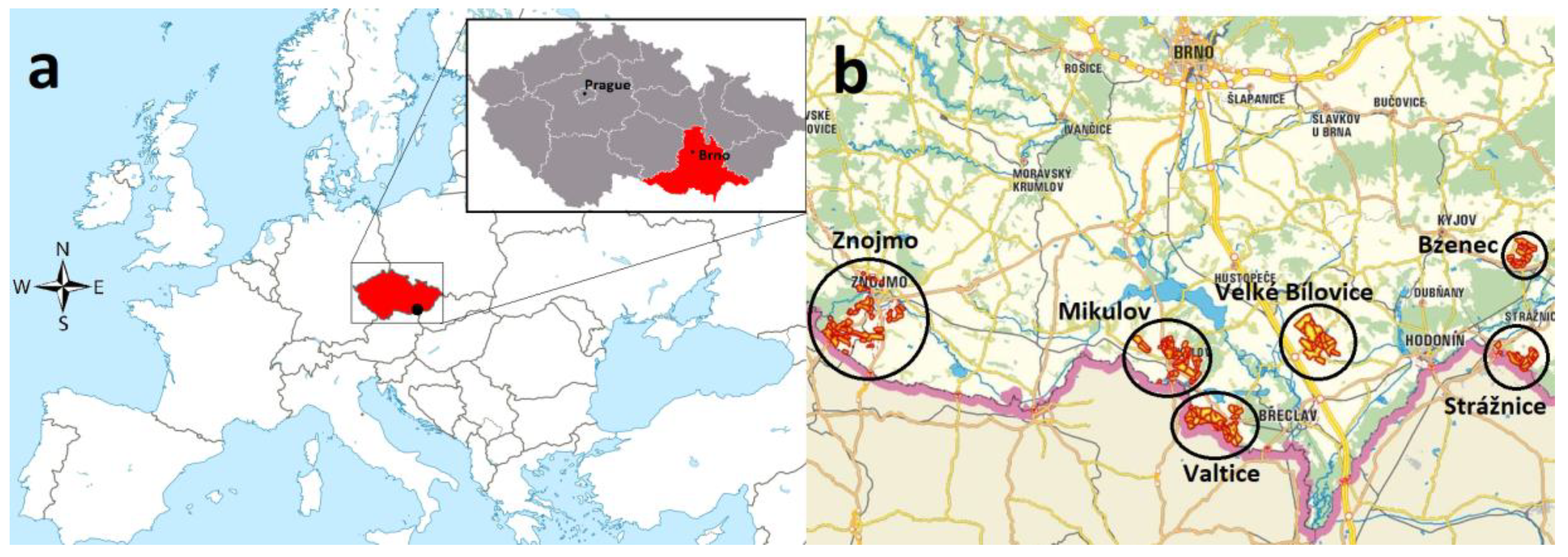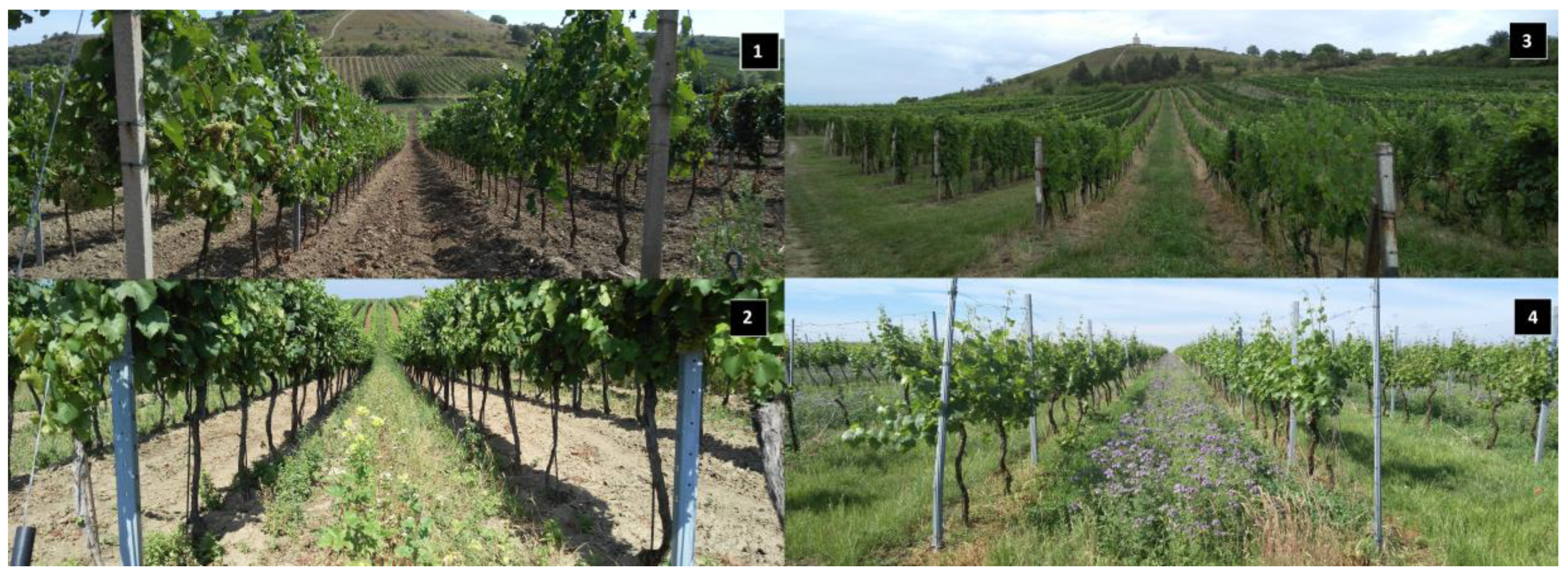The Current Stage of Greening Vegetation in Selected Wine-Regions of South Moravian Region (Czech Republic)
Abstract
:1. Introduction
2. Materials and Methods
3. Results
4. Discussion
5. Conclusions
Author Contributions
Funding
Acknowledgments
Conflicts of Interest
References
- Carlos, C.; Alfonso, S.; Crespí, A.; Aranha, J.; Thislewood, H.; Torres, L. Biodiversity of plants and arthropods in key ecological structures of vineyards of the Alto Douro region. IOBC/wprs Bull. 2012, 75, 51–55. [Google Scholar]
- Ripoche, A.; Celette, F.; Cinna, J.P.; Gary, C. Design of intercrop management plans to fulfil production and environmental objectives in vineyards. Eur. J. Agron. 2010, 32, 30–39. [Google Scholar] [CrossRef]
- Delpuech, X.; Metay, A. Adapting cover crop soil coverage to soil depth to limit competition for water in a Mediterranean vineyard. Eur. J. Agron. 2018, 97, 60–69. [Google Scholar] [CrossRef]
- Celette, F.; Wery, J.; Chantelot, E.J.; Celette, J.; Gary, C. Belowground interactions in a vine (Vitis vinifera L.)-tall fescue (Festuca arundinacea Shreb.) intercropping system: Water relations and growth. Plant Soil 2005, 276, 205–217. [Google Scholar] [CrossRef]
- Ben-Salem, N.; Álvarez, S.; López-Vicente, M. Soil and Water Conservation in Rainfed Vineyards with Different Plant Covers: Common Sainfoin and Spontaneous Vegetation under Different Physiographic Conditions. Water 2018, 10, 1058. [Google Scholar] [CrossRef]
- Trigo-Córdoba, E.; Bouzas-Cid, Y.; Orriols-Fernández, I.; Díaz-Losada, E.; Mirás-Avalos, J. Influence of cover crop treatments on the performance of a vineyard in a humid region. Span. J. Agric. Res. 2015, 13, 0907. [Google Scholar] [CrossRef]
- Biddoccu, M.; Ferraris, S.; Opsi, F.; Cavallo, E. Long-term monitoring of soil management effects on runoff and soil erosion in sloping vineyards in Alto Monferrato (North–West Italy). Soil Tillage Res. 2016, 155, 176–189. [Google Scholar] [CrossRef]
- Lopes, C.; Monteiro, A.; Rücker, F.E.; Gruber, B.; Steinberg, B.; Schultz, H.R. Transpiration of grapevines and co-habitating cover crop and weed species in a vineyard. A “snapshot” at diurnal trends. Vitis 2004, 43, 111–117. [Google Scholar]
- Monteiro, A.; Lopes, C. Influence of cover crop on water use and performance of vineyard in Mediterranean Portugal. Agric. Ecosyst. Environ. 2007, 121, 336–342. [Google Scholar] [CrossRef]
- Steenwerth, K.; Calderon-Orellana, A.; Hanifin, R.; Storm, C.; McElrone, A. Effects of Various Vineyard Floor Management Techniques on Weed Community Shifts and Grapevine Water Relations. Am. J. Enol. Vitic. 2016, 67, 153–162. [Google Scholar] [CrossRef]
- Celette, F.; Gaudin, R.; Gary, C. Spatial and temporal changes to the water regime of a Mediterranean vineyard due to the adoption of cover cropping. Eur. J. Agron. 2008, 28, 153–162. [Google Scholar] [CrossRef]
- Fourie, J.; Agenbag, G.; Louw, P.J.E. Covercrop management in a Sauvignon Blanc/Ramsey vineyard in the semi-arid Olifants River Valley, South Africa. 3. Effect of different cover crops and cover crop management practices on the organic matter and macro-nutrient contents of a sandy soil. S. Afr. J. Enol. Vitic. 2007, 28, 131–139. [Google Scholar]
- Thorup-Kristensen, K.; Magid, J.; Jensen, L.S. Catch crops and green manures as biological tools in nitrogen management in temperate zones. Adv. Agrono. 2003, 79, 227–302. [Google Scholar]
- Tribouillois, H.; Cohan, J.-P.P.; Justes, E. Cover crop mixtures including legume produce ecosystem services of nitrate capture and green manuring: assessment combining experimentation and modelling. Plant Soil 2016, 401, 347–364. [Google Scholar] [CrossRef]
- Landis, D.; Wratten, S.; Gurr, G. Habitat Management to Conserve Natural Enemies of Arthropod Pests in Agriculture. Annu. Rev. Entomol. 2000, 45, 175–201. [Google Scholar] [CrossRef] [PubMed]
- Roy, G.; Wateau, K.; Legrand, M.; Oste, S. Refuges, flower strips, biodiversity and agronomic interest. Commun. Agric. Appl. Biol. Sci. 2008, 73, 351–359. [Google Scholar] [PubMed]
- Winkler, K. Assessing the Risk and Benefits of Flowering Field Edges. Strategic Use of Nectar Sources to Boost Biological Control. Ph.D. Thesis, Wageningen University, Wageningen, The Netherland, 2005. [Google Scholar]
- Kopta, T.; Pokluda, R.; Psota, V. Attractiveness of flowering plants for natural enemies. Zahradnictví Hortic. Sci. 2012, 39, 89–96. [Google Scholar]
- Fiedler, A.K.; Landis, D.A.; Wratten, S.D. Maximizing ecosystem services from conservation biological control: The role of habitat management. Biol. Control 2008, 45, 254–271. [Google Scholar] [CrossRef]
- Miglécz, T.; Valkó, O.; Török, P.; Deák, B.; Kelemen, A.; DonkóÁ.;Drexler, D.; Tóthmérész, B. Establishment of three cover crop mixtures in vineyards. Sci. Hortic. 2015, 197, 117–123. [Google Scholar]
- Tardy, F.; Moreau, D.; Dorel, M.; Damour, G. Trait-based characterisation of cover plants’ light competition strategies for weed control in banana cropping systems in the French West Indies. Eur. J. Agron. 2015, 71, 10–18. [Google Scholar] [CrossRef]
- Garcia, L.; Celette, F.; Gary, C.; Ripoche, A.; Valdés-Gómez, H.; Metay, A. Management of service crops for the provision of ecosystem services in vineyards: A review. Agric. Ecosyst. Environ. 2018, 251, 158–170. [Google Scholar] [CrossRef] [Green Version]
- Zemědělství, M. Situační a výhledová zpráva: Réva vinná a víno; Ministerstvo zemědělství: Prague, Czech Republic, 2018; ISBN 978-80-7434-471-8. [Google Scholar]
- Government Order on Conditions for Implementation of Agri-Environmental-Climate Measures and on Amendment to Government Order No. 79/2007 Coll., On Conditions for Implementation of Agri-Environmental Measures, as amended. (Nařízení vlády o podmínkách provádění agroenvironmentálně-klimatických opatření a o změně nařízení vlády č. 79/2007 Sb., o podmínkách provádění agroenvironmentálních opatření, ve znění pozdějších předpisů.). Available online: https://www.zakonyprolidi.cz/cs/2007-79 (accessed on 28 August 2019).
- Portal.CHMI.cz. CHMI Portal: Historical Data: Weather: Climate Maps. 2019. Available online: http://portal.chmi.cz/historicka-data/pocasi/mapy-charakteristik-klimatu?l=en (accessed on 22 August 2019).
- Mroczkowski, P. File: Europe political map.svg. Wikipedie. Available online: https://commons.wikimedia.org/wiki/File:Europe_political_map.svg?uselang=cs (accessed on 28 August 2019).
- Anonymous. File: 2004 Jihomoravsky kraj.PNG; Wikipedie. Available online: https://commons.wikimedia.org/wiki/File:2004_Jihomoravsky_kraj.PNG (accessed on 28 August 2019).
- Braun-Blanquet, J. Pflanzensoziologie: Grundzüge der Vegetationskunde [Phytosociology: Fundamentals of Vegetation Science], 3rd ed.; Springer: Vienna, Austria, 1964. (In German) [Google Scholar]
- Ter Braak, C.J.F.; Šmilauer, P. Canoco Reference Manual and User’s Guide: Software for Ordination (Version 5.0); Microcomputer Power: Ithaca, NY, USA, 2012. [Google Scholar]
- Hluchý, M. Analýza možností dotací Integrované produkce révy vinné po zavedení integrované ochrany rostlin jako standardního systému ochrany rostlin v zemědělství České republiky; Ministerstvo zemědělství: Prague, Czech Republic, 2012. [Google Scholar]
- Ekovin.cz. Svaz integrované a ekologické produkce hroznů a vína o.s. 2019. Available online: http://www.ekovin.cz/ (accessed on 24 August 2019).
- Winkler, J.; Kopta, T.; Sochor, J. Botanický monitoring vegetace vinic ve vybraných vinařských obcích Moravy. Úroda 2017, 65, 359–362. [Google Scholar]
- Javůrek, M.; Vach, M. Effect of cover crops in conservation soil tillage systems. In Proceedings of the Agro XIth ESA Congress, Montpellier, France, 29 August–3 September 2010; pp. 241–242. [Google Scholar]
- García-Ruiz, J.M. The effects of land uses on soil erosion in Spain: A review. Catena 2010, 81, 1–11. [Google Scholar] [CrossRef]
- Arnaez, J.; Lasanta, T.; Ruiz-Flaño, P.; Ortigosa, L. Factors affecting runoff and erosion under simulated rainfall in Mediterranean vineyards. Soil Tillage Res. 2007, 93, 324–334. [Google Scholar] [CrossRef]
- Coll, P.; Arnal, D.; Le Cadre, E.; Blanchart, E.; Hinsinger, P.; Villenave, C. Organic viticulture and soil quality: A long term study in Southern France. Appl. Soil Ecol. 2011, 50, 37–44. [Google Scholar] [CrossRef]
- Salomé, C.; Coll, P.; Lardo, E.; Metey, A.; Villenave, C.; Marsden, C.; Blanchart, E.; Hinsinger, P.; Le Cadre, E. The soil quality concept as a framework to assess management practices in vulnerable agroecosystems: A case study in Mediterranean vineyards. Ecol. Indic. 2016, 61, 456–465. [Google Scholar] [CrossRef]
- Le Bissonnais, Y.; Andrieux, P. Impact des modes d’entretien de la vigne sur le ruissellement, l’érosion et la structure des sols: Mécanismes et résultats expérimentaux. Progrés Agricole et Viticole 2007, 124, 191–196. [Google Scholar]
- De Santisteban, L.; Casalí, J.; López, J. Assessing soil erosion rates in cultivated areas of Navarre (Spain). Earth Surf. Process. Landf. 2006, 31, 487–506. [Google Scholar] [CrossRef]
- Čížková, A.; Burg, P.; Mašán, V.; Burgová, J.; Visacki, V. Observing the soil erosion on sloping vineyards when different soil cover applied. In MendelNet 2018: Proceedings of the 25th International Ph.D. Students Conference, Brno, Czech Republic, 7 November–8 November, 1st ed.; Mendelova Univerzita v Brně: Brno, Czech Republic, 2018; pp. 218–223. ISBN 978-80-7509-597-8. [Google Scholar]
- Novara, A.; Gristina, L.; Saladino, S.; Santoro, A.; Cerdà, A. Soil erosion assessment on tillage and alternative soil managements in a Sicilian vineyard. Soil Tillage Res. 2011, 117, 140–147. [Google Scholar] [CrossRef] [Green Version]
- Kabelka, D.; Kincl, D.; Janeček, M.; Vopravil, J.; Vráblík, P. Reduction in soil organic matter loss caused by water erosion in inter-rows of hop gardens. Soil Water Res. 2019, 14, 172–182. [Google Scholar] [CrossRef]
- Ingels, C.H.A.; Scow, K.M.; Whisson, D.A.; Drenovsky, R.E. Effects of Cover Crops on Grapevines, Yield, JuiceComposition, Soil Microbial Ecology, and Gopher Activity. Am. J. Enol. Vitic. 2005, 56, 19–29. [Google Scholar]
- Castillo, P.; Rapoport, H.F.; Rius, J.E.P.; Díaz, R.M.J. Suitability of weed species prevailing in Spanish vineyards as hosts for root-knot nematodes. Eur. J. Plant Pathol. 2008, 120, 43–51. [Google Scholar] [CrossRef]





| Region | Wine-Growing Municipalities | Total Area of Evaluated Vineyard Sites | Total Number of Vineyard Sites in Municipalities |
|---|---|---|---|
| Bzenec | Bzenec, Domanín | 499 ha | 13 |
| Mikulov | Mikulov, Bavory, Březí u Mikulova | 1245 ha | 21 |
| Strážnice | Strážnice, Petrov, Sudoměřice | 570 ha | 16 |
| Velké Bílovice | Velké Bílovice, Moravský Žižkov | 1578 ha | 12 * |
| Valtice | Valtice, Úvaly u Valtic | 1510 ha | 23 |
| Znojmo | Chvalovice, Havraníky, Hnanice, Šatov, Znojmo, Podmolí, Nový Šaldorf-Sedlešovice | 1506 ha | 29 |
| Bzenec | Strážnice | V. Bílovice | Valtice | Mikulov | Znojmo | |
|---|---|---|---|---|---|---|
| Bare soil | 10% | 16% | 19% | 10% | 19% | 16% |
| Alternate greening | 35% | 74% | 57% | 50% | 65% | 69% |
| Full-area cover crop | 55% | 9% | 25% | 40% | 16% | 15% |
© 2019 by the authors. Licensee MDPI, Basel, Switzerland. This article is an open access article distributed under the terms and conditions of the Creative Commons Attribution (CC BY) license (http://creativecommons.org/licenses/by/4.0/).
Share and Cite
Ragasová, L.; Kopta, T.; Winkler, J.; Pokluda, R. The Current Stage of Greening Vegetation in Selected Wine-Regions of South Moravian Region (Czech Republic). Agronomy 2019, 9, 541. https://doi.org/10.3390/agronomy9090541
Ragasová L, Kopta T, Winkler J, Pokluda R. The Current Stage of Greening Vegetation in Selected Wine-Regions of South Moravian Region (Czech Republic). Agronomy. 2019; 9(9):541. https://doi.org/10.3390/agronomy9090541
Chicago/Turabian StyleRagasová, Lucia, Tomáš Kopta, Jan Winkler, and Robert Pokluda. 2019. "The Current Stage of Greening Vegetation in Selected Wine-Regions of South Moravian Region (Czech Republic)" Agronomy 9, no. 9: 541. https://doi.org/10.3390/agronomy9090541
APA StyleRagasová, L., Kopta, T., Winkler, J., & Pokluda, R. (2019). The Current Stage of Greening Vegetation in Selected Wine-Regions of South Moravian Region (Czech Republic). Agronomy, 9(9), 541. https://doi.org/10.3390/agronomy9090541






